Summary During the month of June, 2011, there were several cases of traumatic injuries of elephants being reported that required veterinary attention
Summary
During the month of June, 2011, there were several cases of traumatic injuries of elephants being reported that required veterinary attention. These included injured elephants in Narosura area, Maasai Mara and Ol Donyo Rasha area in Narok. Two elephants were fitted with GPS/GSM collars in Siyapei and Olooltoto areas of Narok, this will enhance monitoring of elephants movements and distribution and provide information that can be used to control human-elephant conflicts in the area. An orphaned elephant calf was rescued at the foot of Oloololo escarpment along Mara river and transported to the elephant orphanage in Nairobi. More detailed reports of all the animal cases attended to during the month of June, 2011 are highlighted in the report below.
Treatment of a wounded elephant in Narosura area, Narok.
This was a case of a sub-adult male elephant which had two deep wounds on the tarsal joint of the right front leg, just above the spool. The wound was already infected with a lot of pus, fluid and necrotic tissue debris accumulation; the elephant barely walk and it was left behind by the rest of the herd since it could not keep pace with the rest of the elephants, it was avoiding much weight on the affected leg. From one of the wounds we extracted an arrow head that was still stuck deep into the wound. The elephant was sighted in a dense bush-land by the community scouts from Narosura group ranch. Chemical immobilization, examination and treatment The elephant was in a very dense bush-land where it could not be easily located; it took us along time of traversing the bushy area on foot trying to locate the elephant for darting. It was then darted using 16mgs of etorphine Hcl and 1000 i.u hyaluronidase, the drug took effect after about 5 minutes and it became recumbent. The two wounds were cleaned with a lot of water and gauze swabs removing all the mud, necrotic tissue debris and pus from the infected site, and then the wound was probed carefully using a long forceps to find out if there was a foreign material inside and how deep it penetrated into the tissues. In the process of probing an arrow head of about 6 inches was extracted from the wound. The wound was further cleaned using 10% hydrogen peroxide then treated with a tincture of iodine and oxytetracycline spray. Further treatments by intramuscular administration of long-acting oxytetracycline antibiotics, multivitamins were provided. Blood and hair samples were collected for testing of various infections such as bovine tuberculosis. Revival of anaesthesia and prognosis The elephant was revived from anaesthesia using 48mgs of diprenorphine hydrochloride administered through the superficial ear-vein. The elephant had a good prognosis after the removal of the arrow head from the wound and treatment. The animal was still very active with good appetite and in good body condition by the time of treatment; this will greatly improve its chances of survival.
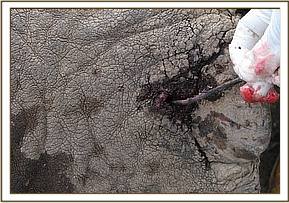

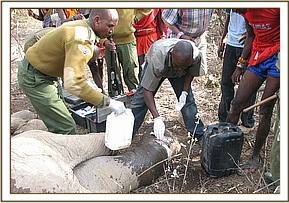

Collaring of elephants in Siyapei and Olooltoto areas of Narok.
There is need for intensive daily monitoring of elephant populations in Narok area in order to reduce incidences of human-elephant conflict (HEC). Recent increase in human population and settlements, expansion of agricultural land in wildlife habitats, loss of wildlife habitat are some of the reasons for increase of human-elephant conflict cases in the area. Crop destruction, human injuries and deaths are the most prevalent effects of human-elephant interaction in Narok area. Two adult female elephants were captured and fitted with GPS/GSM collars, one was at Siyapei area and the other one was at Olooltoto area. The elephant herds were sighted and identified from a helicopter, then the right candidate was darted from a helicopter using Dan-inject dart gun. The first elephant was darted using 17mgs of etorphine Hcl combined with 1000 i.u of hyaluronidase, while the second elephant was darted using 16mgs of etorphine Hcl combined with 1000 i.u hyaluronidase. The collars were adjusted to size and fitted to each elephant one at a time, the collars were designed to use mobile phone network cover and send GPS locations of elephants at an interval of 4 hours everyday for the next 5 years. About 2 litres of blood was also collected from each elephant using vaccutainer blood bags coated with anticoagulants, this was meant to be used for raring young orphaned elephants at the orphanage. Revival of anaesthesia After fitting of the collar, the elephant was revived from anaesthesia using 48mgs of diprenorphine hydrochloride administered through the superficial ear-vein, the collaring exercise was quite successful and both the collared elephants joined the rest of elephant herds without any complications.
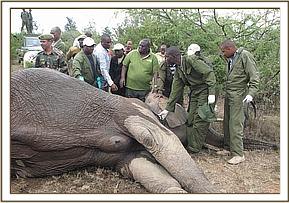
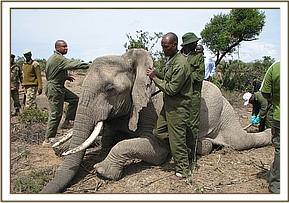

Rescue of an orphaned elephant calf from Mara North Conservancy.
This was a young male elephant calf (approximately 1.5 years) that was found alone at the foot of Oloololo escarpment along Mara river near Mara Timbo camp. It had been in the area for a period of about 3 days without the mother or any other elephant herd around. Arrangements were then made to capture it and transport it to the elephant orphanage at the David Sheldrick Wildlife Trust, Nairobi for tender care before being released back to the wild. Tranquillization and transportation to orphanage The calf was captured by darting using 40mgs of azaperone (Stressnil®) delivered by Dan-inject dart gun, followed by physical strain using ropes and blankets. The calf was then examined by the vet and found to be in a stable health even though it was beginning to loose its body condition and getting dehydrated. It was then covered using warm blankets and loaded onto a pick-up vehicle which took it to Kichwa Tembo airstrip. The calf was then flown to the David Sheldrick Wildlife Trust elephant orphanage in Nairobi for tender care. It had good chances of surviving in the orphanage because it had not been infected by any disease and had a very good appetite. It had developed signs of bloat caused by grazing and browsing without milk at that age.


Treatment of an adult female elephant in Maasai Mara NR
This was a case of an adult female elephant in a group of 4 other elephants; it had a young calf of about 2 years old. The elephant was in severe pain and could not even walk at the same pace with other elephants. It had one penetrating wound slightly above the tarsal joint. It was suspected that the animal could have been stabbed by a sharp object probably an arrow that later on dropped off. The affected leg was entirely swollen and the elephant could barely walk. Chemical immobilization, examination and treatment The elephant was darted from a vehicle using 17mgs of etorphine Hcl and 1500 i.u, the drug took effect after about 6 minutes and it became recumbent. The wound was cleaned with a lot of water and gauze swabs then probed carefully using a long forceps, there was no foreign object in the wound. The injury extended into the tarsal joint where soft tissues, cartilages and bones were injured. The wound was cleaned and debrided using 10% hydrogen peroxide and it was slit open to enhance drainage of all the accumulated pus and tissue debris, then further treated with a tincture of iodine and oxytetracycline spray and intramuscular administration of long-acting oxytetracycline antibiotics, Revival of anaesthesia and prognosis After treatment the elephant was revived from anaesthesia using 60mgs of diprenorphine hydrochloride administered through the superficial ear-vein. The elephant had a fairly good prognosis after the treatment except for the risk of developing arthritis.

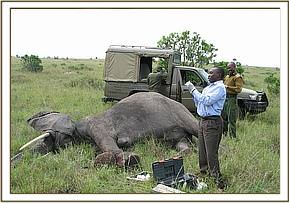

Treatment of a wounded elephant in Ol Donyo Rasha area, Narok.
This was a case of an adult male elephant which had an abscess and a wound on the dorsal side of the right front leg penetrating straight into the tarsal joint. The wound was already infected and the entire leg was extremely swollen almost double the size of a normal leg. The injury was quite painful and the bull elephant remained on one spot for several hours without much movement. It was suspected to have been stabbed by a poisoned arrow head that led to extensive myositis, oedema and severe inflammation of the entire leg. Chemical immobilization, examination and treatment The elephant was darted on foot using 18mgs of etorphine Hcl and 1500 i.u hyaluronidase; the drug took effect after about 10 minutes when it went down on the lateral side. The wound was probed carefully using a long forceps and was found to have penetrated up to about 4 inches deep into the joint. A lot of pus and necrotic tissue debris were drained from the wound in an attempt to reduce the swelling and enhance chances of healing, the injury extended into the bones of the joint and the animal had a very high risk of developing arthritis. After examination, it was realized that there was no foreign material in the affected area, the wound was then cleaned and treated using a tincture of iodine and oxytetracycline spray. Further treatments using long-acting oxytetracycline antibiotics, multivitamins and dexamethasone were provided. Revival of anaesthesia and prognosis After treatment the elephant was immediately revived from anaesthesia using 60mgs of diprenorphine hydrochloride administered through the ear-vein. It had a poor prognosis due to the effect of the poisoned arrow that caused the injury. The rangers were advised to keep monitoring it daily and report the progress just incase the elephant requires further attention.
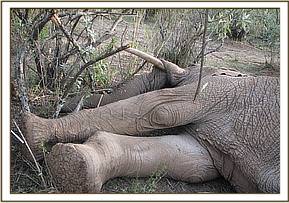

Conclusion During the month of June, 2011, veterinary activities in the Mara ecosystem and Central Rift region have been very successful and most of the reported cases are being attended to and treated promptly as expected. We wish to acknowledge the support of the David Sheldrick Wildlife Trust towards provision of wildlife veterinary services in Maasai Mara and other parts of the Central Rift Conservation area; this has significantly contributed to the general wildlife conservation in these areas which are facing the challenge of human-wildlife conflict and loss of wildlife habitat. Report by: Dr. Domnic Mijele